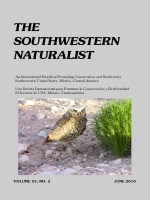In central Texas, western cottonmouths (Agkistrodon piscivorus) inhabit small, low-productivity limestone streams characterized by variability in seasonal flows. An 11-year study of western cottonmouths was conducted at Honey Creek, a spring-fed stream flowing 3.2 km to its confluence with the Guadalupe River, Comal County, to determine how this predator used space in this narrow, linear, and dynamic system. During 57 searches along the 1,564-m study area, 39 sexually mature, 14 subadults, and 4 juvenile snakes were marked. Rates of recapture did not differ between sexes, but females outnumbered males (2.3∶1) and adults were recaptured more frequently than juveniles. Distances between captures were less than predicted if distributions were random, and distances did not vary with number of times captured or time between captures.
How to translate text using browser tools
1 June 2010
Use of Space by Western Cottonmouths (Agkistrodon piscivorus) Inhabiting a Variable–Flow Stream
Francis L. Rose,
Thomas R. Simpson,
James R. Ott,
Richard W. Manning
ACCESS THE FULL ARTICLE

The Southwestern Naturalist
Vol. 55 • No. 2
June 2010
Vol. 55 • No. 2
June 2010




